Physical Address
304 North Cardinal St.
Dorchester Center, MA 02124
The appearance of the head and face, their contours and texture, often provides the first insight into the nature of illness. Sunken cheeks, wasting of the temporal muscles, and flushing of the face are important visible clues of systemic illness. Some facial appearances are pathognomonic of disease. The pale, puffy face of nephritis, the startled expression of hyperthyroidism, and the immobile stare of Parkinsonism are examples of classic facies.
The appearance of the patient's face may also provide information regarding psychologic makeup: is the person happy, sad, angry, or anxious?
Thyroid disease takes many forms. The World Health Organization estimates that more than 200 million people in the world have enlarged thyroid glands, a condition known as goiter. Asians first described goiter around 1500 BCE. Even at that time, they recognized that seaweed in the diet tended to make goiters smaller. Iodine was not discovered until the 19th century, but it is now believed that those goiters were related to an iodine deficiency that was partially corrected by the iodine in the seaweed.
The ancient Greeks and Romans recognized that when a thin thread tied around the neck of a newly married woman broke, she was pregnant. This was caused by an increase in the size of the thyroid during pregnancy.
Almost one-third of the world's population lives in areas of iodine deficiency. 1
1 Vanderpump MPJ. The epidemiology of thyroid disease. Br Med Bull. September 1, 2011;99(1):39–51, https://doi.org/10.1093/bmb/ldr030 .
In areas where the daily iodine intake is less than 50 µg, 2
2 The daily recommended dietary allowance for iodine is 150 µg for adults; 220 µg for pregnant women; and 290 µg for breastfeeding women.
goiter is usually endemic, and when the daily intake falls less than 25 µg, congenital hypothyroidism is seen. The prevalence of goiter in areas of severe iodine deficiency can be as high as 80%. Populations at particular risk tend to be remote and live in mountainous areas in Southeast Asia, Latin America, and Central Africa.
In iodine-replete areas, most persons with thyroid disorders have autoimmune disease, ranging from primary atrophic hypothyroidism, Hashimoto's thyroiditis to thyrotoxicosis caused by Graves’ disease.
Thyroid cancer is the most common endocrine cancer, and its incidence has increased by approximately 3% per 100,000 people per year. The thyroid is the fifth leading site of new cancers in women. The probability of developing thyroid cancer in a lifetime is 0.6% (1 in 160 for men) and 1.8% (1 in 56 for woman). According to the American Cancer Society, in 2018 there were 53,990 new cases of thyroid cancer (40,900 in women, and 13,090 in men). There were about 2060 deaths from thyroid cancer (1100 women and 960 men). Risk factors include radiation exposure related to medical treatment during childhood. The 5-year survival rate for all thyroid cancer patients is 97%. Survival, however, varies markedly by stage, age of diagnosis, and disease subtype. The 5-year survival rate approaches 100% for localized disease, is 97% for regional stage disease, and 58% for distant stage disease.
The chance of being diagnosed with thyroid cancer has risen in recent years and is the most rapidly increasing cancer in the United States, tripling in the past three decades. Much of this rise appears to be the result of the increased use of thyroid ultrasound, which can detect small thyroid nodules that might not otherwise have been found in the past.
Head and neck cancer accounts for about 4% of all cancers in the United States. In 2018, 64,690 people (47,650 men and 17,040 women) developed head and neck cancer. While younger people can develop the disease, most people are older than 50 when they are diagnosed. There were 13,740 deaths (10,250 men and 3490 women) from head and neck cancer in 2018.
Head and neck cancer includes cancers of the mouth, nose, sinuses, salivary glands, throat, and lymph nodes in the neck. Most begin in the moist tissues that line the mouth, nose, and throat. Symptoms include a lump or sore in the mouth that does not heal, a persistent sore throat, trouble swallowing, or a change or hoarseness in the voice. Using tobacco or alcohol increases the risk of developing head and neck cancer. In fact, 85% of all head and neck cancers are linked to tobacco use. Tobacco use includes smoking cigarettes, cigars, or pipes, chewing tobacco, and using snuff. It is the single largest risk factor for head and neck cancer. Eighty-five percent (85%) of head and neck cancers are linked to tobacco use. If found early, these cancers may be curable. Treatment can include surgery, radiation therapy, chemotherapy, or a combination, but these treatments may affect eating, speaking, or even breathing.
Chewing areca nuts is another well-known risk factor for head and neck squamous cell carcinoma. 3
3 Gupta PC, Warnakulasuriya S. Global epidemiology of areca nut usage. Addict Biol . 2002;7:77–83.
The areca nut is the fruit of the areca palm, which grows in much of the tropical Pacific, Southeast and South Asia, and parts of east Africa. It is commonly referred to as a betel nut . Smoking with or without betel nut chewing is a common practice in Asia. Betel nut chewing is a unique problem in India and other Southeast Asian countries, especially Taiwan. The reasons for betel nut consumption are for its psycho-stimulating effects causing a euphoric feeling, heightened alertness, sweetening breath, as a digestive, or as a cultural practice. The nut is a highly addictive substance with a severity score resembling that of amphetamines. In Taiwan, betel nuts are chewed often by truck and bus drivers who have long work hours and need to stay awake while driving at night.
The skull is composed of 22 bones, 14 in the face alone. This bony structure acts as a support and protection for the softer tissues within.
The facial skeleton is composed of the mandible, the maxilla, and the nasal, palatine, lacrimal, and vomer bones. The unpaired mandible forms the lower jaw. The maxilla is an irregular bone and forms the upper jaw on each side. The nasal bones form the bridge of the nose. The other bones are not relevant to this discussion.
The main bones of the cranial skeleton include the frontal, temporal, parietal, and occipital bones. The frontal bones form the forehead. The temporal bones form the anterolateral walls of the brain. The mastoid process , which is part of the temporal bone, is particularly important in ear disease and is discussed in Chapter 11 , The Ear and Nose. The parietal bones form the top and posterolateral portions of the skull. The occipital bones form the posterior portion of the skull. The bones of the face and skull are shown in Fig. 9.1 .
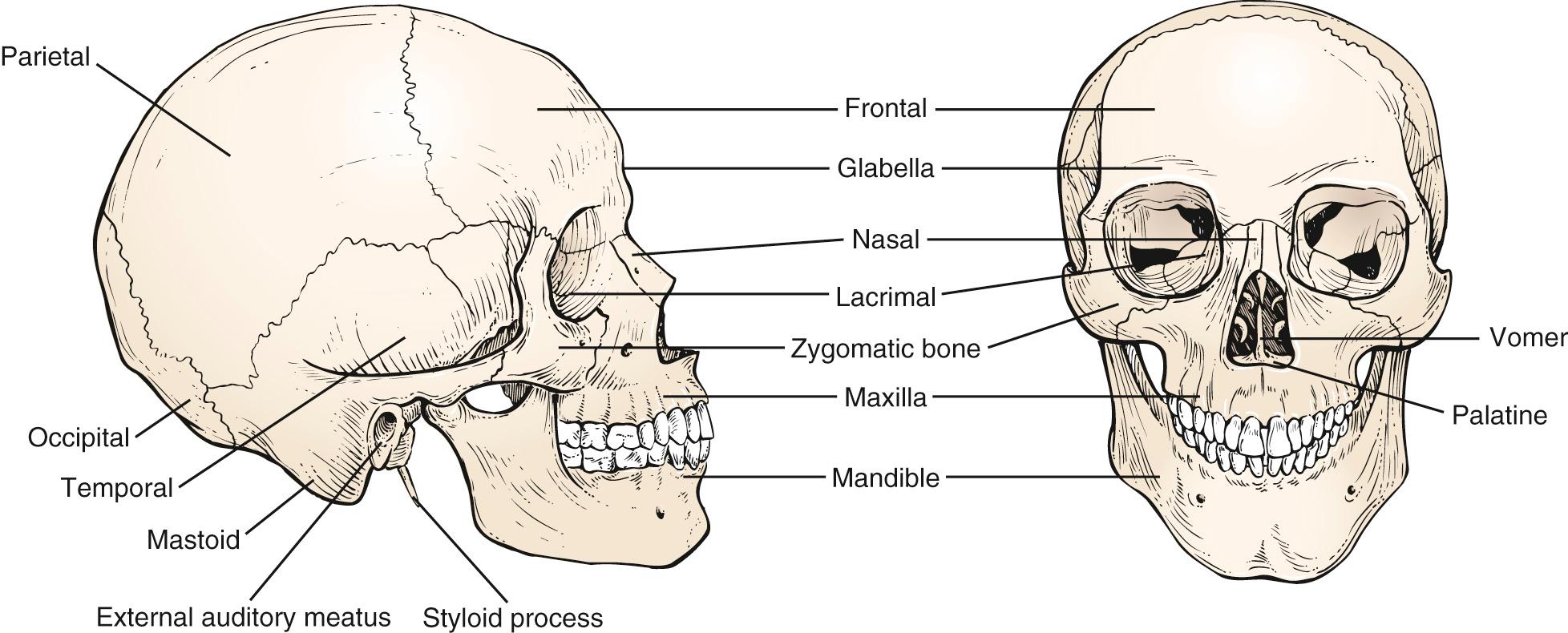
The principal muscle of the mouth is the orbicularis oris. This single muscle surrounds the lips, and numerous other facial muscles insert into it. The action of the orbicularis oris is to close the lips.
The orbicularis oculi muscle surrounds the eye. Its function is to close the eyelids. This muscle and its action are further discussed in Chapter 10 , The Eye.
The platysma is a thin, superficial muscle of the neck, crossing the outer border of the mandible and extending over the lower anterior portion of the face. The main action of the platysma is to pull the mandible downward and backward, which results in a mournful facial expression.
The muscles of mastication include the masseter, pterygoid, and temporalis. These muscles insert on the mandible and effect chewing. The masseter is strong and thick and is one of the most powerful muscles of the face. The action of the masseter is to close the jaw by elevating and drawing the mandible backward. Tension in the masseter may be felt by clenching the jaw. Although important to jaw function, the other muscles of mastication are not clinically relevant to physical diagnosis and are not discussed here. The locations of these muscles are shown in Fig. 9.2 .
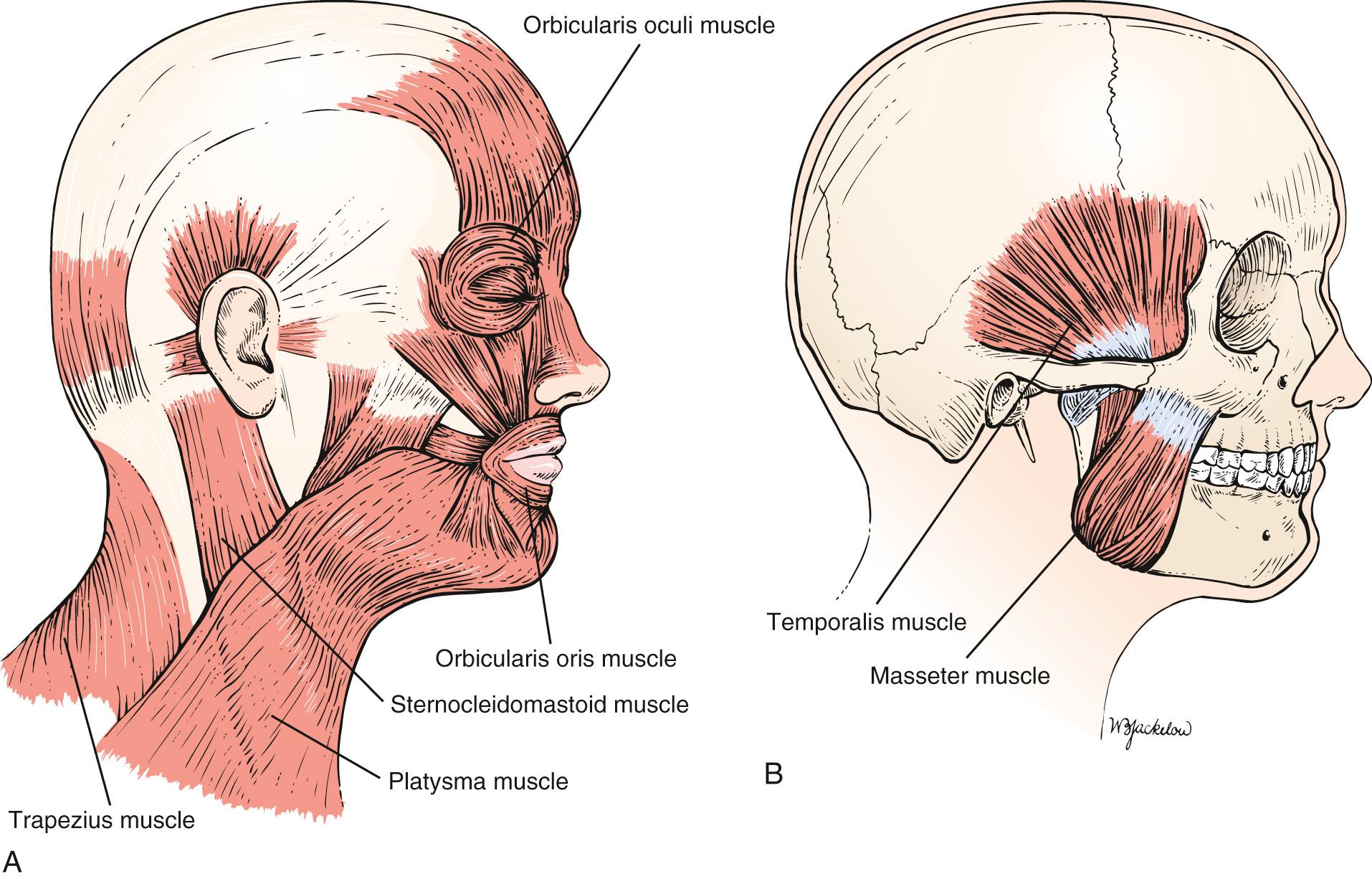
The trigeminal , or fifth cranial, nerve carries sensory fibers from the face, oral cavity, and teeth and carries efferent motor fibers to the muscles of mastication. The major divisions of this nerve are discussed in subsequent chapters.
The neck is divided by the sternocleidomastoid muscle into the anterior , or medial , triangle and the posterior , or lateral , triangle . These are illustrated in Fig. 9.3 .
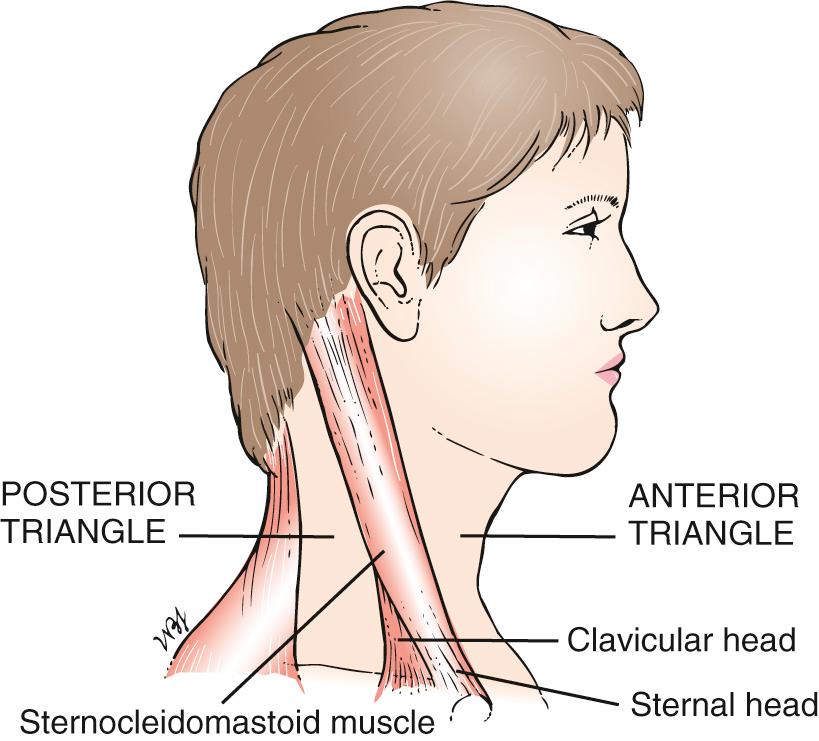
The sternocleidomastoid is a strong muscle that serves to raise the sternum during respiration. The sternocleidomastoid has two heads: the sternal head arises from the manubrium sterni, and the clavicular head originates on the sternal end of the clavicle. The two heads unite and insert on the lateral aspect of the mastoid process. The sternocleidomastoid is innervated by the spinal accessory , or eleventh cranial, nerve.
Anterior to the sternocleidomastoid muscle is the anterior triangle . The other boundaries of the anterior triangle are the clavicle (inferiorly) and the midline (anteriorly). The anterior triangle contains the thyroid gland, larynx, pharynx, lymph nodes, submandibular salivary gland, and fat.
The thyroid gland envelops the upper trachea and consists of two lobes connected by an isthmus. It is the largest endocrine gland in the body. As seen from the front, the thyroid is butterfly-shaped and wraps around the anterior and lateral portions of the larynx and trachea, as shown in Fig. 9.4 .
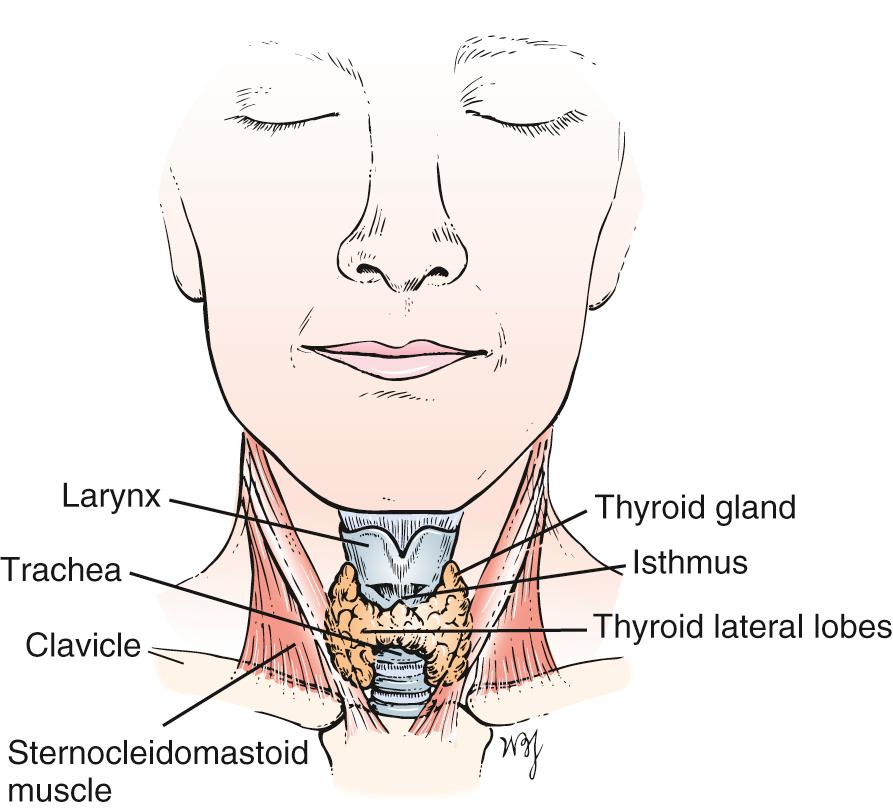
The thyroid isthmus lies across the trachea just below the cricoid cartilage of the larynx. The lateral lobes extend along both sides of the larynx, reaching the middle of the thyroid cartilage of the larynx. On occasion, the thyroid gland may extend downward and enlarge within the thorax, producing a substernal goiter. The function of the thyroid gland is to produce thyroid hormone in accordance with the needs of the body.
The pharynx and larynx are discussed in Chapter 12 , The Oral Cavity and Pharynx.
The sternocleidomastoid muscle overlies the carotid sheath . The carotid sheath lies lateral to the larynx. This sheath contains the common carotid artery, the internal jugular vein, and the vagus nerve.
Posterior to the sternocleidomastoid is the posterior triangle . This is bounded by the trapezius muscle posteriorly and by the clavicle inferiorly. The posterior triangle also contains lymph nodes.
It has been estimated that the neck contains more than 75 lymph nodes on each side. The chains of these lymph nodes are named for their location. Starting posteriorly, they are the occipital , posterior auricular , posterior cervical , superficial and deep cervical (adjacent to the sternocleidomastoid muscle), tonsillar , submaxillary ( or submandibular) , submental (at the tip of the jaw in the midline), anterior auricular , and supraclavicular (above the clavicle) chains. Knowledge of lymphatic drainage is important because the presence of an enlarged lymph node may signal disease in the area draining into it. The main groups of lymph nodes and their drainage areas are shown in Fig. 9.5 .
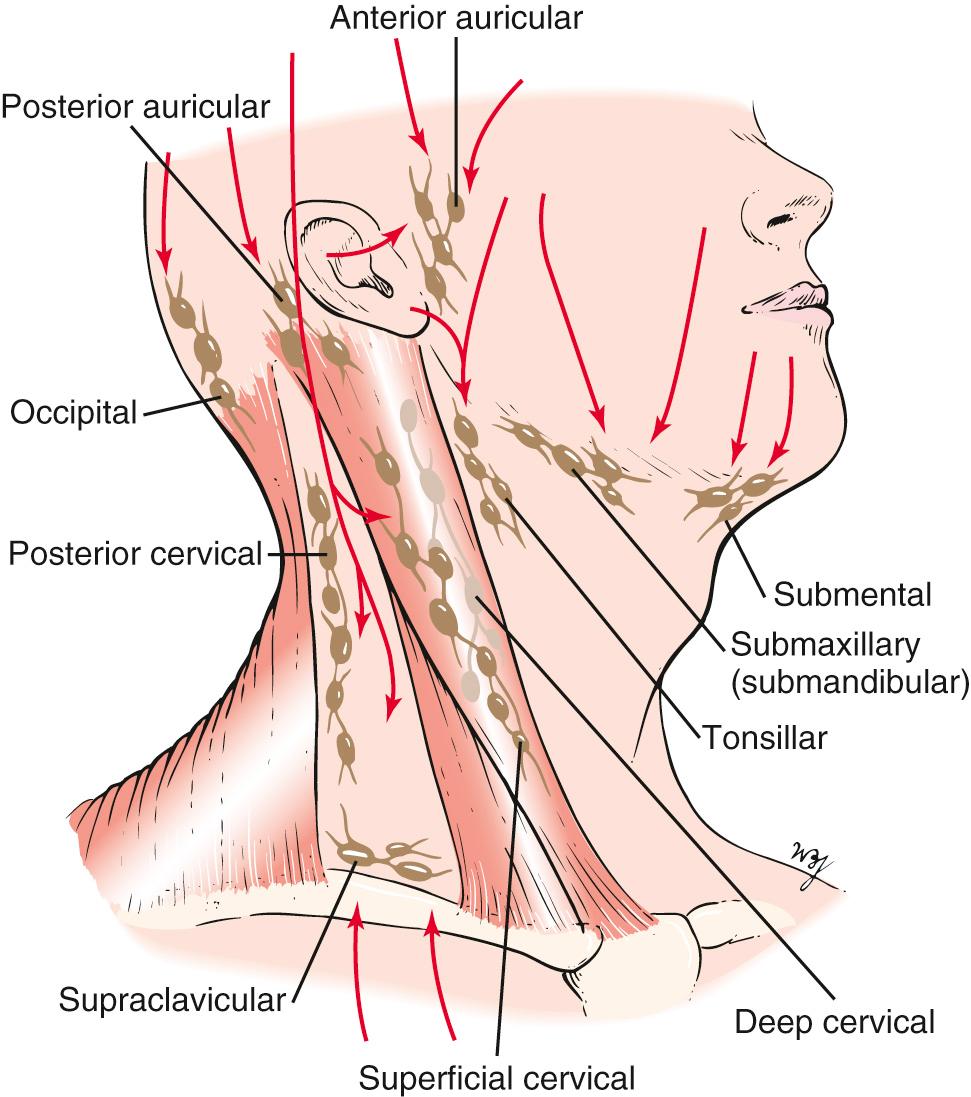
Become a Clinical Tree membership for Full access and enjoy Unlimited articles
If you are a member. Log in here